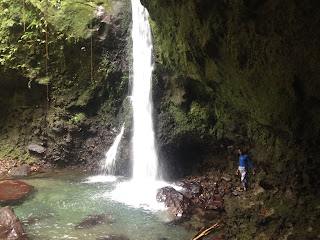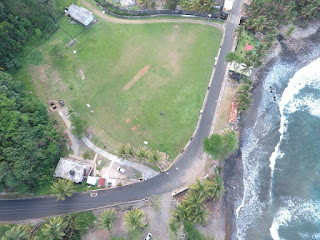One day we took a bus to the Calabishie area. While there, we explored Hodges Bay Beach, near where my Kentucky friends stayed during their visit earlier this month. This isolated Hodges Bay has a river that empties into the ocean, some rocky offshore islands, and some interesting red rock formations to climb around. The first picture below shows an overview of this secluded beach from a hill above the bay (notice the river cutting through the beach). The second picture looks up the river from the beach. The third picture is as far south as I was able to go along the rocks. The last picture looks out towards some large rocks in the ocean just off the beach. I hope these four pictures convey the beauty of this little known beach--just one of many on "the Nature Island."
If the four pictures above aren't enough to convince you about how beautiful Hodges Bay really is, perhaps some aerial drone videos will convince you. [I'm amazed at how well drones perform these days--his had a lot of range and produced outstanding videos!] My friend put some of the videos he made with his drone on YouTube, and I think they are amazing. Click on this link to see my favorite 90 second video. If you want to see more, check out his other videos on that YouTube page, all of which show the wild beauty of Hodges Bay.
On another day, a group of us went to Batibou Beach. It is down the Atlantic coastline from our village. The first shot was taken from the access road rounding a curve on a cliff above the beach. That isn't another aerial drone picture--that's taken from the edge of the cliff. The other shot was taken on the beach itself (with the hillside cliff in the background).
Not far from Batibou Beach is the old Hampstead Estate, along the Hampstead River. We walked there after leaving Batibou. What makes this deteriorating remnant from colonial days interesting is that it was the site for the filming of a famous scene from “Pirates of the Caribbean – Dead Man's Chest.” A swordfight takes place at an old mill, whose waterwheel eventually breaks free. The combatants continue their swordfighting while maintaining their balance as the wheel rolls through the jungle. The first picture below shows the abandoned concrete roadway built solely for a waterwheel to roll on during the filming (I knew about this because my neighbor in the village had worked for the movie production company during the filming). The second photo is the old mill building itself. The last photo is original waterwheel at this old mill, which is still firmly attached (and not rolling through the jungle).
Finally, a group of students accompanied me out of our valley, across the ridge, and down into the Blenhim River valley, which we followed to where it empties into the sea. Before reaching the sea, the river widens and deepens prior to crossing the beach. Below is a picture of me on this isolated beach, which despite its proximity, none of my students had ever visited before. [This had been my intended destination the day we ended up walking to a hotel for an impromptu pool party, and the previous blog story about that day includes a nice picture looking down on this beach from the hillside.]
While there, we decided to see if we could build a raft from the bamboo that littered this wild beach. Some of the boys gathered some vines and started lashing together some similarly sized (about 6-8 feet) bamboo trunks. I admired their ingenuity, but I saw four very long pieces that I thought could be used without vines. My thought was the longer length would provide flotation, and the width of just four would allow the passengers to use their legs to hold the raft together. Below is a shot of this makeshift bamboo kayak on its successful maiden voyage (using a shorter piece of bamboo as a paddle). Of course, with its success, everyone wanted to get their chance, so when it came back to shore, everyone wanted to climb on. Unfortunately, there was a limit as to how many it could take, as shown in the picture below. However, everyone had a great time! We might need to hike there again someday with proper tools and materials to see if we can make a better bamboo boat. It is a beautiful location! I love Dominica!












































